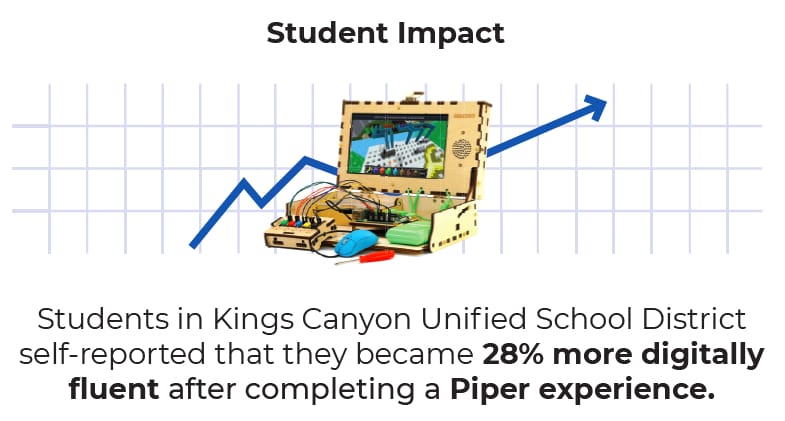CASE STUDY
Piper Summer Learning Program Efficacy - Kings Canyon

EXECUTIVE SUMMARY
KEY FINDINGS
METHODS
Introduction:
Piper’s mission is to demystify technology by creating STEAM opportunities and solutions for students through hands-on and project based learning experience. With a standards aligned curriculum and professional development, teachers are equipped with all of the tools they need to facilitate STEAM learning in their classrooms. This impact report was created to summarize the role the Piper Computer Kit played in helping students at Kings Canyon Unified School District advance their skills in problem solving, critical thinking, collaborative learning, computer science, and digital fluency.
*Note: The report below outlines the results of self-reported findings for students using Piper in the Kings Canyon Unified School District during a 5-week Summer Learning Program. The results were analyzed in-house by Piper. This is not a formal efficacy study by a third party.
Executive Summary:
- Student-Reported Increase in Knowledge, Skills, and Mindset in Computer Science
- Students showed a significant growth in their digital fluency and effective collaboration
- Students showed notable growth in their comfort with cognitive dissonance, metacognition, grit & perseverance as well as critical thinking
Key findings:
- Students showed greater levels of mastery in computer science concepts associated with the construction of a working computer and coding
- Students have a greater understanding of how everyday devices work following the Piper Computer program
- Students showed their ability to apply learned concepts with the intent of making something happen
- After students used Piper, they self-reported growth in their ability to assess and explain their own work and think metacognitively
- Students displayed more comfort in the process of problem-solving, demonstrating resilience in solving difficult computer science related problems and in the ability to help other classmates with coding
- Student grit & perseverance increased after using Piper and students developed a better growth mindset towards problem solving
- Students showed an increase in their ability to think critically and work through difficult problems
Methods:
The data below was collected using online surveys for student growth in the areas of: critical thinking, problem solving, computer science, perseverance, team building and communication. The survey tool was inspired by studies in conjunction with UChicago Center for Elementary Mathematics and Science Education UCLA CRESST that has previously been used by Exploring Computer Science in their efficacy studies.
Teachers were trained on and provided with a Google Form survey to administer to their students before they begin and at the conclusion of their Piper Computer Kit program. Students answered questions by choosing a response on the likert scale of 1-7, 1 being “Strongly Disagree” and 7 being “Strongly Agree”. Data was collected electronically and analyzed in Google Sheets by calculating the percent change in average score as well as statistical significance by a Piper Content Engineer. Students completed the same survey before they completed the Piper program and again at the conclusion of the Piper program in order to ensure they were answering these questions.
A sample size of n= 106 was collected for the Pre Self Assessment and Post Self Assessment. Piper utilized a unique identifier tool to omit extraneous data. The survey followed FERPA and COPPA requirements.
|
Kings Canyon USD By the Numbers |
|
80% Free and Reduced Lunch |
|
30% English Language Learners |
|
40 Foster Care Students |



Results: Computer Science
After using Piper, students scored themselves higher in their ability to build a working computer. This is a 43.1% increase in digital fluency.

Students self-reported increase in ability to apply learned concepts including successfully use software to perform a tasks and create devices. 34.3% and 49.3% increase in application ability.

Students showed a 28.6% increase in their ability to both differentiate between different hardware and software and know the functions of each in the context of building a working computer.

Results: Problem Solving
Students self reported growth in their ability to code and demonstrated mastery in their ability to aid other classmates in coding with A 17.7% increase in the post assessment.

Students self-reported that they were more comfortable with cognitive dissonance when solving problems. In addition, students self-reported an increased level of perseverance when facing difficulty. Both results display a stronger growth mindset in problem solving. A 25.2% and 19.5% increase respectively.

Results: Critical Thinking
Participation in the Piper program resulted in growth in students ability to demonstrate metacognition when completing computer science problems. A 26.4% increase was reported.

Student comfort with cognitive dissonance and critical thinking towards solving difficult problems was improved. A 21.7% increase was measured in the post survey results.

Results: Gender Outcomes
The Piper experience proved paramount in increasing digital fluency and grit amongst all students. There were two metrics that showed greater improvement for girls in the categories of problem solving and computer science.
The girls self-reported lower scores in the pre assessment, which means they showed greater growth. The overall percent change from pre to post assessment was 35.63% overall compared to 48.70% increase in girls alone.

Girls ranked themselves higher in their ability to apply learned concepts such as connecting circuits and coding physical devices. A 67% increase amongst girls was recorded compared to 49.3% increase overall.


